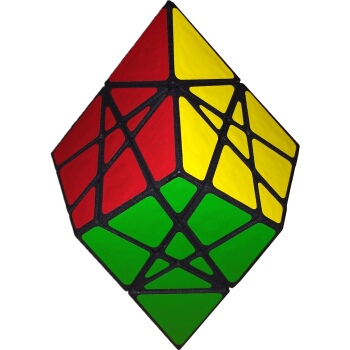
Above:View 1
Click a thumbnail to see its larger version and description.
A jumbling only puzzle which fills a missing slot in the series of face turning tetragonal trapezohedrons between the Crystal Trap and the jumble Trap.
This design was the result of a discussion between the designer and Joseph Wong who designed the Crystal Trap. The original Crystal Trap design was running into unintended blockages inside the puzzle because the feet of the mechanism were actually sticking into the jumbling territory of the Star Trap, which is one puzzle deeper cut than the Crystal Trap.
The Star Trap has the shape of a Tetragonal Trapezohedron and utilizes the cuts of that geometry. There are 8 grips, and 83 pieces, including the core - 50 external and 33 internal. There are 10 uniquely-shaped pieces.
Joseph Wong has stated that he considered designing the Star Trap but ultimately decided not to pursue it due to concerns about internal jumbling blocking moves that appear possible from the surface of the puzzle. It is indeed possible for the Star Trap to reach shapes where an apparently available move is blocked only by internal pieces not visible from the surface. However, many of these types of internal blockages can be made available again by adding the exact same stored cuts previously used on the Jumble Trap Unbandaged and Crystal Trap. Having discovered this, the designer did include this completely internal stored cut in the Star Trap design. The Star Trap includes therefore stored cuts that only affect strictly internal pieces. (Unbandaged Helicopter Cube, Mystic Totem, and Quirky Gem II are all examples of puzzles where a stored cut splits an external piece into one internal and one external piece, but the piece before the stored cut was still external!)
Tracking all of these stored cuts across the Tetragonal Trapezohedron family is confusing, so here is a quick overview, where a piece created by a stored cut retains the letter of the piece it came from followed by a number:
- The Jumble Trap contains piecetypes A,B,C,D,E, and F, all on the surface of the puzzle.
- The Jumble Trap Unbandaged contains piecetypes A,B,C1,C2,D,E,F. C1 happens to be identical to piecetype B.
- A theoretical "rebandaged" Crystal Trap covers up piecetypes A and B and introduces piecetype G. Note this puzzle does not exist, yet.
- The actual Crystal Trap contains piecetypes A,B,C1,C2,D1,D2,E,F,G. C1 is identical to B and internal while C2 is external, and they are the same as the Jumble Trap Unbandaged's C1 and C2 pieces. D1 is the corner piece and now has triangular symmetry (wheres D did not) and D2 is identical to G.
- Finally, the Star Trap contains piecetypes A,B,C1,C2,D,E,F,G,H,I, with 8xA, 8xB, 8xC1, and 8xC2 (and the core) being the 33 internal pieces. Again, C1 is identical to B.
So the Star Trap contains the same stored cut splitting piecetype C as the Crystal Trap and the Jumble Trap Unbandaged, but not the stored cut across piecetype D that the Crystal Trap introduced - the cuts just don't work out the same way on the Star Trap. By the way, if you move the cutplanes on the Star Trap any deeper, you will have the Gemstone II by Ben Streeter (see the museum), so the Star Trap really is the missing link in the Tetragonal Trapezohedron family.
Height (from tip to tip): 120 mm
Diameter (inner sphere): 60 mm
Links

Contributors
No one has contributed to this page yet!
Collections
This puzzle can be found in collections of these members:
Found a mistake or something missing?
Edit it yourself or
contact the moderator.





